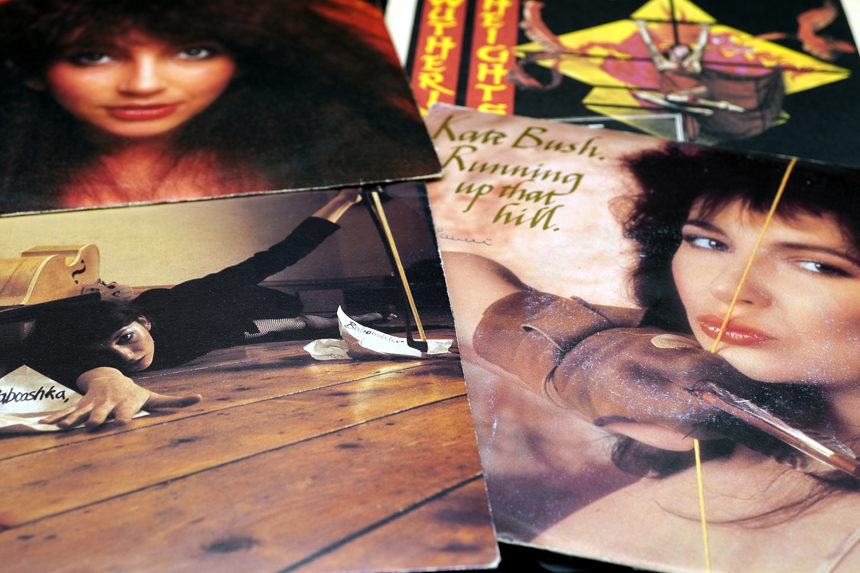Media outlets love to tell you that someone or something is “having a moment.” It’s fair to say of Kate Bush, whose 1985 Hounds of Love track “Running Up That Hill” stormed the charts worldwide after its recent inclusion in the fourth season of Stranger Things. Bush belongs to a much larger tradition that’s generally referred to as “art rock.” 50 years ago this summer, art rock itself was having a grand moment as Bush had begun writing songs for the first time, Ziggy was born, Roxy debuted, and Floyd began a journey to the Moon.
“Be My Baby” by The Ronettes, produced and co-written by Phil Spector (Uploaded to YouTube by The Ronettes)
Music historian Matthew Bannister is one of the people who suggests that the concept of Art rock began with famed producer Phil Spector. His “wall of sound” approach involved using a variety of additional instruments, musicians, and studio effects to amplify the impact of a song. It also cast the producer in the role of auteur. Spector’s general approach influenced Brian Wilson of The Beach Boys, who began to incorporate outside musicians and grander ideas. Wilson’s efforts ran in tandem with The Beatles and their producer George Martin, who were also expanding their sonic palette.
“Wouldn’t It Be Nice” from Pet Sounds (Uploaded to YouTube by Beach Boys)
Wilson realized his vision on 1966’s Pet Sounds, generally agreed by critics and artists to be among the finest albums ever made (it sits at #2 on Rolling Stone’s revised 2020 list of the 500 Greatest Albums). Paul McCartney has repeatedly asserted over the years that Sounds, along with Freak Out! by Frank Zappa and the Mothers of Invention, pushed The Beatles in the direction that resulted in Sgt. Pepper’s Lonely Hearts Club Band the following year. 1967 also saw the arrival of The Velvet Underground & Nico; produced by Tom Wilson and (in name, at least) Andy Warhol, The Velvet Underground brought a darker sensibility to rock that also included alternative tunings, lengthy droning passages, and a heavy use of distortion. Bands like King Crimson and Pink Floyd continued to push the sonic spaces with virtuoso guitar players and wide-ranging influences.
50 years ago, 1972 saw the release of two classic art rock albums, the beginning of another, and the baby steps of an enduring career. In mid-June, The Rise and Fall of Ziggy Stardust and the Spiders from Mars by David Bowie and the self-titled Roxy Music were released on the same day. Ziggy Stardust deployed the tropes of the concept album, with the songs connected by a traditional dramatic tragedy narrative about an alien that attempts to play the role of savior on Earth but allows his ego to topple him. Roxy Music was more of a traditional album structure, but several songs carried direct inspiration from classic films.
“Starman” from The Rise and Fall of Ziggy Stardust and the Spiders from Mars (Uploaded to YouTube by David Bowie)
Ziggy Stardust would have seismic impact across the music scenes in both the U.K. and the U.S. It was a landmark for art rock, a major inspiration in glam rock, and it made Bowie a star. While Bowie’s greatest American successes were yet to come, he planted a flag for character-driven rock that had been established by the likes of Vincent Furnier, better known as Alice Cooper; Alice Cooper had begun life as a band, but it eventually morphed into Furnier’s full-time musical persona. Bowie went in the opposite direction, in later years conceiving of different looks and identities like Aladdin Sane and The Thin White Duke.
“Re-Make/Re-Model” from Roxy Music (Uploaded to YouTube by Roxy Music)
The musicians of Roxy Music pushed the boundaries of rock instrumentation. Andy Mackay played saxophone, but also incorporated oboe on tracks like “Ladytron.” Lead singer Bryan Ferry played a variety of keyed instruments, from traditional piano to Mellotron to the electric Hohner Pianet. Additionally, Brian Eno deployed the VCS3 synthesizer, adding sonic textures that made Roxy sound classic and futuristic at the same time. Visually, the band incorporated a kind of space-age glam aesthetic. They would become major influences on Duran Duran, who would eventually induct their heroes into the Rock and Roll Hall of Fame.
“Time” from The Dark Side of the Moon (Uploaded to YouTube by Pink Floyd)
As that one-two punch of art rock was drawing new listeners, established stars Pink Floyd were toiling in the studio. On the last day of May in 1972, they set about recording one of the most popular British albums of all time. A good bit of the lyrical content was inspired by their former frontman, Syd Barrett. Barrett had been a founding member but departed in 1968 amid struggles with mental afflictions and drug use. In the studio, engineer Alan Parsons would work with the band, who self-produced the album, to incorporate a variety of synthesizers. The sessions would run until February of 1973 and result in the conceptual classic The Dark Side of the Moon. While some acts (Floyd included) could be circumspect about their themes, a number of songs (“Time,” “Money,” “Brain Damage,” etc.) carried on-the-nose titles about their subject matter. Pink Floyd had been at the vanguard of experimentation for years, but Dark Side shot them into the stratosphere, becoming one of the best-selling albums of all-time.
“Wuthering Heights” (Uploaded to YouTube by KateBushMusic)
Pink Floyd’s guitarist David Gilmour would soon play an instrumental role in the career of another major figure in art rock. During that summer of 1972, a 14-year-old girl from Kent began writing her first songs. She came from a musically inclined family, and by 11, she began to play piano, organ, and violin. Her name was Catherine, but professionally, she’d go by Kate. Kate Bush put together a demo tape that had 50 of her self-written pieces on it, but couldn’t get any traction from record labels. Over time, that demo got into Gilmour’s hands through mutual friends of the Bush family. Understanding Bush’s potential, Gilmour paid for a new demo of three songs and saw to it that it was produced by Andrew Powell and engineered by Geoff Emerick, who worked on Sgt. Pepper. The updated demo got Bush a deal with EMI records, and Powell would produce her first two albums, including her debut hit single, “Wuthering Heights.” Bush has gone on to have one of the most lauded musical careers in the U.K., having been the first woman to have an album hit #1 as a solo artist and the first woman to have an album debut at #1.
Over the decades, dozens of high-profile acts have continued work in the art rock frame. Though Bowie passed in 2016, he remained a beloved figure in music and his constant reinventions set the stage for the likes of Madonna and Lady Gaga that followed. Roxy Music split in 1983, but had their first reformation in 2001; after a lengthy hiatus, they reconvened this year to tour in celebration of the 50th anniversary of their debut album. Pink Floyd’s original run lasted until 1994; the years since have seen a few reunions here and there, notably at the Live8 concert. In 2022, Gilmour and Nick Mason reunited as Pink Floyd and joined other musicians in recording “Hey, Hey, Rise Up!” in support of Ukraine. But no one has had a bigger 2022 than Kate Bush. The use of her classic “Running Up That Hill” in Stranger Things season 4 drove an amazing resurgence that saw the song hit #1 all over the world, including the U.K. and the U.S. The notoriously press-shy Bush has released several statements expressing her delight at both the show (of which she was already a fan) and the embrace of her music by a new generation of listeners.
If art rock was about anything, it was about finding new paths to creativity and invigorating the familiar with fresh energy. That so many influential acts can be said to exist in that space seems to prove that following a muse can result in just as much, and more fulfilling, success. The grand takeaway might be that the pursuit of art for art’s sake is always a positive thing. As Ziggy himself sang, “He’s told us not to blow it/’Cause he knows it’s all worthwhile.”
Become a Saturday Evening Post member and enjoy unlimited access. Subscribe now



